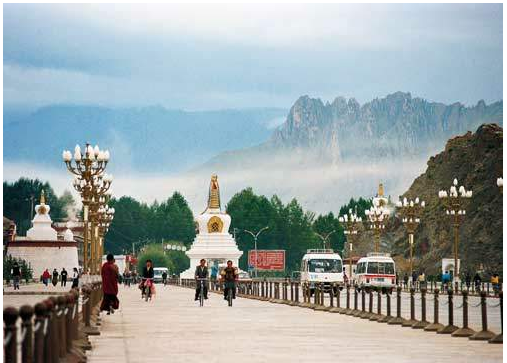The Forbidden City Of The World-Lhasa-Tibet.

Lhasa literally means “place of the gods”. Originally Lhasa was called Rasa, it was a town built by the Otang lake, and it was so called because when the water in the lake was stirred by wind would make the sound “Rasala”. Lhasa is first recorded as the name, referring to the area’s temple of Jowo, in a treaty drawn up between China and Tibet in 822 C.E. In the seventh century, at the time of Songtsen Gampo,this lake-perhaps it was more of a marsh-was filled in with the help of a mythical goat, and the Jokhang Cathedral was built on the site. It first became the capital of Tibet during his reign. Although the king used Lhasa as his summer capital, the rulers continued to be buried in the Chonggye Valley near Yarlung for the remainder of the dynasty he inaugurated. There are still nine sites in or around Lhasa that are associated with Songtsen Gampo. The most important of these are the chapels of the Potala that he built and the Jokhang and the Ramoche Cathedrals. Songtsen Gampo gave the town the name Lhasa, which means” ground of the gods” The Tibetan etymology of the name states that the city is called ground” Sa” of the gods ”Lha” because it is as though a lofty realm of the gods had fallen to the ground through the richness of the Dharma. Lhasa has an elevation of about 3,600 m (11,800 ft) and lies in the center of the Tibetan Plateau with the surrounding mountains rising to 5,500 m (18,000 ft). The air only contains 68 percent of the oxygen compared to sea level. Due to its very high elevation, Lhasa has a cool semi-arid climate with frosty winters and mild summers, yet the valley location protects the city from intense cold or heat and strong winds. With monthly percent possible sunshine ranging from 53 percent in July to 84 percent in November, the city receives nearly 3,000 hours of sunlight annually and is thus sometimes called the “sunlit city” by Tibetans. The coldest month in Tibet is said to be January and the warmest month of the Tibet is said to be June. The city is also renowned as “The Forbidden City”, the city was romantically imaged to possess inconceivable treasures, to preserve ancient wisdom and to be home to great mystics and saints. Lhasa is the second most populous city on the Tibetan plateau after Xining and one the highest city on the earth. The city has been the religious and administrative capital of Tibet since the mid-17th century. It contains many culturally significant Tibetan Buddhism sites such as the Potala Palace, Jokhang Palace, and Norbulingka Palaces.
Recent Posts
Exploring the Beauty of Tibetan Handicraft
The Ultimate Guide to Tibet Tours, Travel, and Trekking Adventures
How to Explore Tibetan Culture
All Categories
- About Tibet
- book a Tibet tour
- Buddhism Practice
- Budget Tour
- China-Tibet Train
- Customized Tibet tour
- Historical Sites
- Hot Springs in Tibet
- News
- Photography in Tibet
- Tibet attraction
- Tibet Group Visa
- Tibet Motorcycle Tour
- Tibet Small Group Tours
- Tibet Tours and Tibetan Tour Guide
- Tibet Train
- Tibet Travel FAQs
- Tibet Travel Information
- Tibet Travel News
- Tibet Travel Permit Update
- Tibet Travel Prices Rises
- Tibet Trek
- Tibet Trekking Tour
- Tibet weather and climate
- Tibet Wildlife animals
- Tibet Winter Tour
- Tibetan Buddhism
- Tibetan Cultural Features
- Tibetan Culture and Poeple
- Tibetan Festivals
- What to see in Tibet



